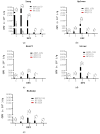Novel Experimental Mouse Model to Study the Pathogenesis and Therapy of Actinobacillus pleuropneumoniae Infection
- PMID: 38787263
- PMCID: PMC11123673
- DOI: 10.3390/pathogens13050412
Novel Experimental Mouse Model to Study the Pathogenesis and Therapy of Actinobacillus pleuropneumoniae Infection
Abstract
Actinobacillus pleuropneumoniae (APP) is a major cause of lung infections in pigs. An experimental mouse has the edge over pigs pertaining to the ease of experimental operation, disease study and therapy, abundance of genetic resources, and cost. However, it is a challenge to introduce APP into a mouse lung due to the small respiratory tract of mice and bacterial host tropism. In this study, an effective airborne transmission of APP serovar 1 (APP1) was developed in mice for lung infection. Consequently, APP1 infected BALB/c mice and caused 60% death within three days of infection at the indicated condition. APP1 seemed to enter the lung and, in turn, spread to other organs of the mice over the first 5 days after infection. Accordingly, APP1 damaged the lung as evidenced by its morphological and histological examinations. Furthermore, ampicillin fully protected mice against APP1 as shown by their survival, clinical symptoms, body weight loss, APP1 count, and lung damages. Finally, the virulence of two extra APP strains, APP2 and APP5, in the model was compared based on the survival rate of mice. Collectively, this study successfully established a fast and reliable mouse model of APP which can benefit APP research and therapy. Such a model is a potentially useful model for airway bacterial infections.
Keywords: Actinobacillus pleuropneumoniae; clinical score; inflammation; lung; mouse model; pleuropneumonia; pulmonary bacterial infection.
Conflict of interest statement
The authors declare no conflict of interest.
Figures




Similar articles
-
B cell cross-epitope of Propionibacterium acnes and Actinobacillus pleuropneumonia selected by phage display library can efficiently protect from Actinobacillus pleuropneumonia infection.Vet Microbiol. 2017 Jun;205:14-21. doi: 10.1016/j.vetmic.2017.04.026. Epub 2017 Apr 29. Vet Microbiol. 2017. PMID: 28622855
-
Effects of fisetin on virulence of Actinobacillus Pleuropneumoniae.Microb Pathog. 2025 Aug;205:107692. doi: 10.1016/j.micpath.2025.107692. Epub 2025 May 12. Microb Pathog. 2025. PMID: 40368071
-
Establishment and comparison of Actinobacillus pleuropneumoniae experimental infection model in mice and piglets.Microb Pathog. 2019 Mar;128:381-389. doi: 10.1016/j.micpath.2019.01.028. Epub 2019 Jan 18. Microb Pathog. 2019. PMID: 30664928
-
Actinobacillus pleuropneumoniae: pathobiology and pathogenesis of infection.Microbes Infect. 2002 Feb;4(2):225-35. doi: 10.1016/s1286-4579(01)01534-9. Microbes Infect. 2002. PMID: 11880056 Review.
-
Actinobacillus pleuropneumoniae: The molecular determinants of virulence and pathogenesis.Adv Microb Physiol. 2021;78:179-216. doi: 10.1016/bs.ampbs.2020.12.001. Epub 2021 Jan 25. Adv Microb Physiol. 2021. PMID: 34147185 Review.
Cited by
-
Immunogenicity and vaccine efficacy of Actinobacillus pleuropneumoniae-derived extracellular vesicles as a novel vaccine candidate.Virulence. 2025 Dec;16(1):2453818. doi: 10.1080/21505594.2025.2453818. Epub 2025 Jan 20. Virulence. 2025. PMID: 39831520 Free PMC article.
-
Drosophila melanogaster experimental model to test new antimicrobials: a methodological approach.Front Microbiol. 2024 Nov 6;15:1478263. doi: 10.3389/fmicb.2024.1478263. eCollection 2024. Front Microbiol. 2024. PMID: 39568995 Free PMC article. Review.
References
-
- Paz-Sánchez Y., Herráez P., Quesada-Canales Ó., Poveda C.G., Díaz-Delgado J., Quintana-Montesdeoca M.d.P., Plamenova Stefanova E., Andrada M. Assessment of Lung Disease in Finishing Pigs at Slaughter: Pulmonary Lesions and Implications on Productivity Parameters. Animals. 2021;11:3604. doi: 10.3390/ani11123604. - DOI - PMC - PubMed
MeSH terms
Substances
Grants and funding
LinkOut - more resources
Full Text Sources
Molecular Biology Databases
Research Materials

